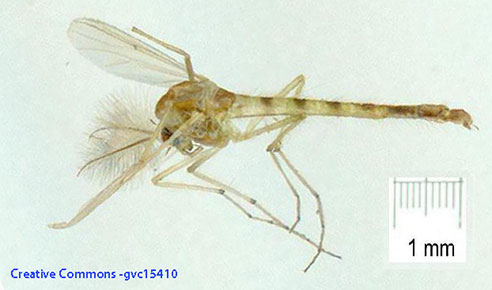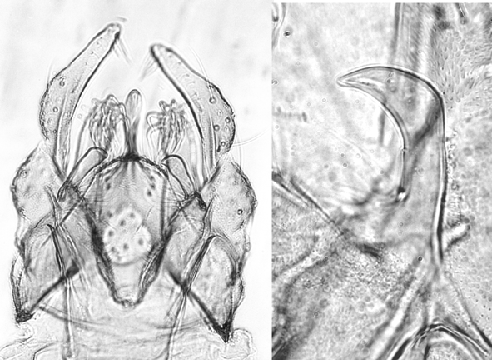"Chironomus flaviplumus"This species is related to C. flaviplumus in Japan, but a new name is needed for this species (Martin 2011b), so C. orientalis is suggested. Adults:  Adult from Queensland (photo by Graeme V. Cocks)  Frontal tubercles about 33 - 39 µm, and about 3 times longer than wide. Palp proportions (micron): 44 : 53 : 189 : 222 : 315 Wing length: 2.85 - 3.15 mm; wing width 0.30 - 0.67 mm. VR about 1.02-1.07; abt 2-4 SCf on brachiolum; 9-14 setae in squamal fringe. Thoracic setae - achrostichal about 12-18; dorsocentral about 13-18; prealar about 4-6; supra alar 1; scutellar in 2 approximate rows, 6-7 in anterior row, 11-17 in posterior row. Legs pale, lengths (micron) and proportions as follows:
The superior volsella is essentially a D(e)-type of Strenzke (1959), although often of a beaked type not illustrated by Strenzke (1959), i.e. it varies between a D- and an almost S-type. Setae on 9th tergite: 9 - 12; some setae on inferior volsellae with a simple or trifid fork; gonostylus reduces fairly quickly over posterior half. Female: Leg proportions (micron)
ant Ta4/Ti about 0.98; Ta3 and Ta4 subequal in length. Differences from other members of the C. samoensis/flaviplumus group: Molecular Sequence: Found: Northern Territory - Radon Creek, Kakadu National Park; (12.75°S, 132.93°E); Twin Falls, off Jim Jim Road, Kakadu area Indian specimens described by Chattopadhyuy et al. (1991), are not the same species and one has been renamed C. indiaensis (Martin 2011b), while others are the widespread species PK2. Australian adults of this species can be bred in the laboratory, as fertile egg masses were obtained from adults reared from wild collected larvae. The related Japanese species has also been maintained in a laboratory culture (Elbetieha & Kalthoff 1988). |
Modified: 24 May 2018
Access: Unrestricted
Copyright © 2005-2018, Jon Martin.